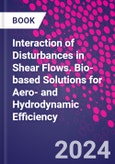Interaction of Disturbances in Shear Flows aims to provide a comprehensive, in-depth overview of the current state of knowledge on the subject.
Authored by a recognized expert with decades of experience and many software patents to his credit, the volume covers advances in computational fluid dynamics to showcase innovative ways to apply physical measurements and visualization patterns to solve various aero- and hydrodynamic problems. It also delves into analytical methodologies to compare and contrast with the theoretical models most commonly used in the field. Additionally, it demonstrates the significance of comprehending and managing disturbances in shear flows, discussing practical applications of the research to optimize the design of aircraft, automotive vehicles, and marine vessels, with a strong emphasis on enhancing aero- and hydrodynamic efficiency, fuel economy, and the reduction of harmful emissions.
Academia and industry readers alike will find this a useful resource to equip themselves with the tools needed to understand and address practical engineering challenges encountered in their studies or work.
Please Note: This is an On Demand product, delivery may take up to 11 working days after payment has been received.
Table of Contents
1. Interaction of disturbances in the boundary layer
2. Coherent vortex structures in shear flows
3. Analysis of the boundary layer by the tellurium method?when flowing around a rigid plate?
4. Analysis of the boundary layer of a rigid plate with a laser Doppler velocity meter
5. Formation of longitudinal vortices in the boundary layer of elastic plates
6. Implementation of results
7. Formation of vortices in the boundary layer when flowing around cavities
8. Vortex structures in the boundary layer in the flow around vortex generators
9. Coherent vortex structures arising from the flow around wings
10. Control of vortex structures arising in swirling flows








